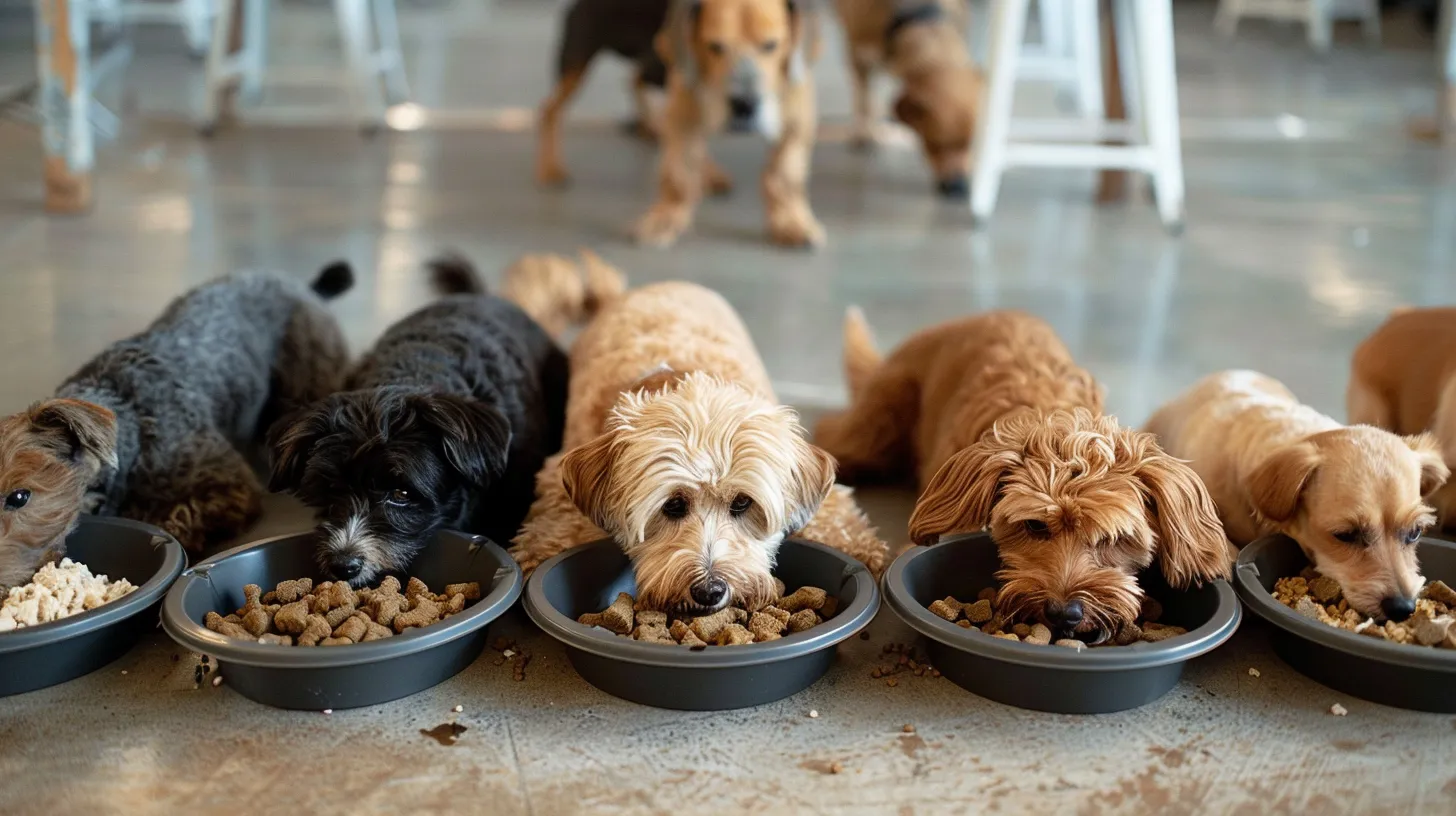Effective Meals for Selective Eaters at Dog Boarding Facilities
Feeding selective eaters at dog boarding facilities can be a challenge, but with the right approach, you can ensure your pet receives proper nutrition during their stay. Modern kennels often utilize technology like webcams and mobile apps to keep pet owners informed about their dog's eating habits and overall well-being. Some facilities even offer personalized pet sitting services to cater to picky eaters' specific needs. In this article, you'll discover effective strategies to help your selective eater thrive during boarding.
Key Takeaways
- Observe and record dogs' eating behaviors to identify selective eaters at boarding facilities
- Create a calm dining environment and maintain consistent feeding schedules for picky eaters
- Use interactive feeding methods like puzzle feeders to engage selective eaters during meals
- Monitor food intake closely and consult veterinarians to ensure proper nutrition for selective eaters
Identifying Selective Eaters at Dog Boarding Facilities

At dog boarding facilities, identifying selective eaters is crucial for ensuring your furry companion receives proper nutrition during their "vacation." While your dog enjoys exercise and accessibility to play lots, the resort-like atmosphere may affect their eating habits. Understanding your dog's food preferences helps staff provide suitable meals, making their stay more comfortable. By observing behavior during meal times, recording preferences and dislikes, and communicating with you for insights, boarding facilities can better cater to your dog's dietary needs.
Observe Behavior During Meal Times
Watch your dog's behavior during meal times at the boarding facility. Look for signs of excitement, like tail wagging, or hesitation when food is presented. Staff should note if your dog eats immediately or takes time to approach their bowl. These observations help identify selective eaters and ensure proper nutrition during their stay, much like how you'd monitor their vaccine schedule or consult an FAQ for health concerns.
- Observe tail wagging or hesitation
- Note immediate eating or delayed approach
- Monitor food consumption patterns
- Adjust meals based on observations
Record Preferences and Dislikes
Record your dog's food preferences and dislikes to help boarding facilities provide suitable meals. This attention to detail ensures your puppy's happiness and well-being during their stay. Share information about favorite treats, toy-based feeding methods, or any medication that needs to be administered with food. Communicate these preferences to the caregiver to maintain your dog's regular eating habits:
- Favorite food types and brands
- Preferred feeding times
- Any food allergies or sensitivities
- Special dietary requirements
- Treat preferences for rewards
Communicate With Pet Owners for Insights
Engage with pet owners to gain valuable insights about their dog's eating habits, especially for breeds like Yorkshire Terriers known for their selective palates. Ask about their dog's health history, including any dietary restrictions or allergies, to ensure proper meal planning. Inquire about the dog's rabies vaccination status and other relevant health information, as this can impact their appetite and overall well-being during their stay. By giving each dog individual attention and tailoring their meals based on owner input, you'll provide a more personalized boarding experience that pet parents will appreciate, potentially leading to positive reviews and repeat business.
Customizing Meals for Picky Dogs in Boarding

When running a dog boarding business, catering to selective eaters is crucial for ensuring your clients' pets stay healthy and content during their stay. Whether you offer daycare or overnight dog boarding services, customizing meals for picky dogs can set your facility apart. By incorporating familiar flavors from home, gradually introducing new foods, and ensuring a balanced diet, you'll create a positive experience for both pets and their owners. This attention to detail can boost your reputation and attract more clients to your website, helping you select the best approach for each dog's unique needs.
Incorporate Familiar Flavors From Home
To make your dog feel at home during pet boarding, incorporate familiar flavors from their regular meals. This approach helps reduce stress and maintains consistency in their diet. Request that pet owners bring their dog's usual food or treats to the facility. You can then mix these familiar items with the boarding facility's offerings, creating a comforting blend that encourages picky eaters to consume their meals. This method is particularly effective for dogs attending a dog boot camp or staying at kennels for dogs, where routines may differ from home:
- Mix the dog's regular food with facility offerings
- Use familiar treats as meal toppers
- Gradually introduce new foods if necessary
- Maintain consistent feeding times
- Offer water from a familiar bowl if possible
Gradually Introduce New Foods
When introducing new foods to selective eaters at dog boarding facilities, take a gradual approach to prevent digestive issues and maintain their comfort. This method is especially important for facilities offering services like puppy boot camp or petsmart dog boarding, where dogs may already be adjusting to a new environment. Start by mixing a small amount of the new food with their regular diet, gradually increasing the proportion over several days. This technique can help reduce stress and make the transition smoother for picky eaters at dog boarding kennels:
- Begin with 25% new food, 75% regular diet
- Increase new food proportion by 25% every 2-3 days
- Monitor the dog's reaction and adjust as needed
- Communicate changes with pet owners
- Consider dog boarding cost when selecting new foods
Ensure a Balanced and Nutritious Diet
When catering to selective eaters at dog boarding facilities, ensuring a balanced and nutritious diet is crucial. This applies to all types of services, including dog boarding for aggressive dogs, regular dog boarding, dog daycare, kennels, and dog overnight boarding. Tailor meals to meet each dog's specific nutritional needs while accommodating their preferences. Consider factors such as age, size, breed, and activity level when planning meals for picky eaters:
- Consult with veterinarians for nutritional guidance
- Offer a variety of protein sources
- Include essential vitamins and minerals
- Provide appropriate portion sizes
- Monitor food intake and adjust as needed
The Role of Mealtime Environment for Selective Eaters

When running a dog boarding facility, creating the right mealtime environment is crucial for selective eaters. Whether you offer long term dog boarding or operate a luxury dog resort, the dining atmosphere can significantly impact a dog's eating habits. By maintaining a calm and quiet dining area, scheduling consistent feeding times, and providing individual attention during meals, you can enhance the experience for picky eaters. These strategies not only cater to selective dogs but also elevate your facility's reputation as the best dog boarding option in your area. Local dog boarding facilities that prioritize a positive mealtime environment often see improved eating habits among their canine guests, leading to happier pets and satisfied owners.
Maintain a Calm and Quiet Dining Area
Creating a peaceful dining environment is essential for selective eaters at dog boarding facilities. Minimize distractions and noise during mealtimes to help dogs focus on their food. Set up separate feeding areas away from high-traffic zones and playrooms. Use sound-absorbing materials to reduce echoes and loud noises that might startle or distract dogs while eating. Consider playing soft, calming music to mask any sudden sounds and create a relaxing atmosphere. This approach can significantly improve the eating habits of picky eaters, especially those staying for extended periods or attending specialized training programs.
- Designate quiet zones for feeding
- Use sound-absorbing materials
- Play soft background music
- Separate feeding areas from play spaces
- Minimize staff movement during mealtimes
Schedule Consistent Feeding Times
Establishing a consistent feeding schedule is crucial for selective eaters at dog boarding facilities. Set specific mealtimes that align with each dog's usual routine at home. This consistency helps reduce stress and anxiety, which can affect appetite. Create a feeding chart for each dog, noting their preferred times and any special instructions. Stick to these schedules as closely as possible, even on weekends or holidays. For dogs staying in luxury suites or participating in specialized programs, consider offering meals in their private areas to maintain a sense of routine and comfort.
- Create individual feeding charts
- Align mealtimes with home routines
- Maintain consistency on weekends and holidays
- Offer meals in private areas when possible
- Adjust schedules for dogs with specific needs
Provide Individual Attention During Meals
Giving individual attention to selective eaters during mealtimes can significantly improve their eating habits at dog boarding facilities. Assign staff members to monitor and encourage picky eaters during their meals. This personal approach allows for immediate adjustments to food presentation or feeding methods if needed. For dogs staying in premium accommodations or participating in training programs, consider hand-feeding or using interactive feeding toys to make mealtimes more engaging. Keep detailed records of each dog's eating patterns and preferences to share with their owners and inform future stays.
- Assign staff to monitor selective eaters
- Adjust feeding methods as needed
- Use interactive feeding toys
- Consider hand-feeding for extremely picky eaters
- Maintain detailed feeding records
Provide Individual Attention During Meals
Offer individual attention to selective eaters during mealtimes at your dog boarding facility. Assign a dedicated staff member to monitor each picky eater, providing gentle encouragement and adjusting the feeding approach as needed. This personalized care can help anxious or stressed dogs feel more comfortable, potentially improving their appetite and overall boarding experience.
Engaging Dogs With Interactive Feeding Methods

At dog boarding facilities, engaging selective eaters with interactive feeding methods can significantly improve their appetite and overall experience. By incorporating puzzle feeders, food-dispensing toys, and reward-based techniques, you can stimulate interest in meals and make eating more enjoyable for picky dogs. These innovative approaches not only encourage food consumption but also provide mental stimulation, reducing stress and boredom during their stay. Implementing these strategies can help you cater to the unique needs of selective eaters, ensuring they receive proper nutrition while fostering a positive boarding experience.
Utilize Puzzle Feeders to Stimulate Interest
Incorporate puzzle feeders into your dog boarding facility's mealtime routine to stimulate interest in food for selective eaters. These interactive tools challenge dogs mentally while encouraging them to work for their meals, making eating a more engaging and rewarding experience. By using puzzle feeders, you can tap into a dog's natural foraging instincts, potentially increasing their appetite and food intake during their stay.
Introduce Variety With Food-Dispensing Toys
Introduce food-dispensing toys to add variety and excitement to mealtime for selective eaters at your dog boarding facility. These interactive toys can turn eating into a fun and engaging activity, encouraging picky dogs to consume their meals. Rotate different types of food-dispensing toys to keep the experience fresh and stimulating, helping to maintain interest in food throughout their stay.
Reward-Based Techniques to Encourage Eating
Implement reward-based techniques to encourage selective eaters at your dog boarding facility. Offer praise, gentle petting, or small treats when a picky dog shows interest in their food or begins eating. Gradually reduce the frequency of rewards as the dog becomes more comfortable with their meals, ensuring they associate positive experiences with eating during their stay.
Monitoring Health and Adjustment of Selective Eaters

When caring for selective eaters at dog boarding facilities, closely monitoring their health and adjustment is crucial. By tracking food intake and behavior, you can quickly identify any issues and make necessary adjustments to meal plans. Regular consultations with a veterinarian ensure that the nutritional needs of picky eaters are met, even in a new environment. These proactive measures help maintain the well-being of selective eaters during their stay, allowing you to provide personalized care that addresses each dog's unique dietary requirements.
Track Food Intake and Behavior
Closely monitor the food intake and behavior of selective eaters at your dog boarding facility. Keep detailed records of each dog's eating habits, noting the amount consumed, any food left uneaten, and any changes in appetite or preferences. Observe their behavior during mealtimes, looking for signs of stress, anxiety, or discomfort that may affect their eating habits.
Adjust Meal Plans Based on Observation
Based on your observations of selective eaters at your dog boarding facility, adjust meal plans to better suit their needs. If you notice a dog consistently leaving certain ingredients untouched, consider removing or replacing them with more appealing alternatives. Increase or decrease portion sizes as needed to ensure each dog receives adequate nutrition without overfeeding or underfeeding.
Regularly Consult With a Veterinarian
Regularly consult with a veterinarian to ensure the health and well-being of selective eaters at your dog boarding facility. Schedule routine check-ups for picky eaters to assess their overall health and nutritional status. Seek professional advice on tailoring meal plans for dogs with specific dietary needs or health conditions:
- Schedule routine veterinary check-ups
- Discuss nutritional concerns and dietary adjustments
- Obtain guidance on managing food allergies or sensitivities
- Assess the need for supplements or specialized diets
- Address any weight management issues
Overcoming Common Challenges With Picky Eaters

Dealing with selective eaters at dog boarding facilities presents unique challenges that require creative solutions. You'll often encounter sudden changes in appetite, which can be concerning for both staff and pet owners. It's crucial to differentiate between simple pickiness and potential health issues to provide appropriate care. Additionally, transitioning dogs to the boarding facility's diet can be a delicate process, especially for those accustomed to specific meals at home. By addressing these common challenges head-on, you can ensure that even the pickiest eaters receive proper nutrition during their stay.
Addressing Sudden Changes in Appetite
When you notice sudden changes in appetite among selective eaters at your dog boarding facility, act quickly to identify the cause and address the issue. Assess potential factors such as stress, environmental changes, or underlying health concerns that may be affecting the dog's appetite. Adjust feeding routines, offer familiar foods, or consult with the pet's owner to find effective solutions that encourage eating and maintain the dog's health during their stay.
Differentiating Between Pickiness and Health Issues
Learn to differentiate between normal pickiness and potential health issues in selective eaters at your dog boarding facility. Watch for signs such as sudden weight loss, lethargy, or changes in bathroom habits, which may indicate underlying health concerns rather than simple food preferences. If you suspect a health issue, consult with the dog's owner and a veterinarian to determine the best course of action.
Strategies for Transitioning to Boarding Facility Diets
Implement gradual transitions to help selective eaters adjust to your boarding facility's diet. Start by mixing small amounts of the facility's food with the dog's regular diet, slowly increasing the proportion over several days. Communicate with pet owners about their dog's usual diet and any preferences or restrictions to create a smooth transition plan tailored to each individual dog.
Conclusion
Effective meals for selective eaters at dog boarding facilities ensure proper nutrition and comfort for dogs during their stay. By observing behavior, customizing meals, and creating a calm dining environment, boarding facilities can cater to picky eaters' needs. Interactive feeding methods and consistent monitoring help stimulate appetite and maintain dogs' health. Addressing common challenges and working closely with pet owners and veterinarians allows boarding facilities to provide top-quality care for even the most selective eaters.
